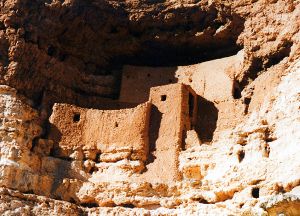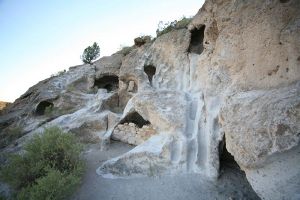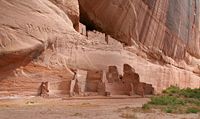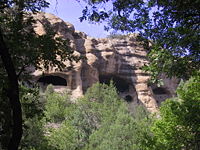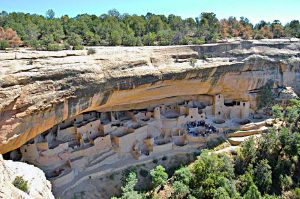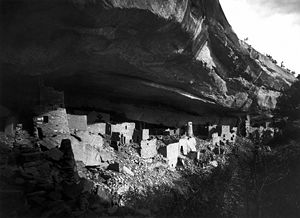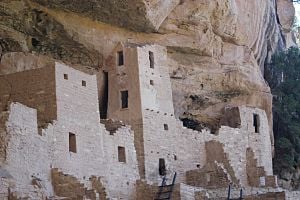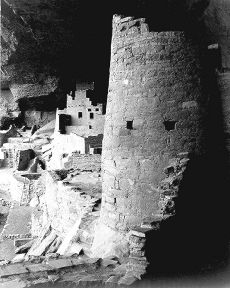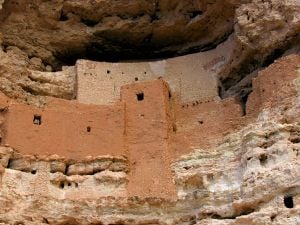Difference between revisions of "Cliff-dwelling" - New World Encyclopedia
| Line 63: | Line 63: | ||
'''Navajo National Monument''' is located within the northwest portion of the [[Navajo]] Reservation in northern [[Arizona]]. It preserves three of the most intact cliff dwellings of the [[ancestral puebloan people]]: the '''Kiet Siel''' (commonly spelled Keet Seel), which stands for "broken house" in Navajo, and '''Betatakin''' (which means "House Built on a Ledge" in Navajo) cliff dwellings, and the '''Inscription House''' site, further west, which is currently closed to public access. These three sites were declared a national monument in 1909. | '''Navajo National Monument''' is located within the northwest portion of the [[Navajo]] Reservation in northern [[Arizona]]. It preserves three of the most intact cliff dwellings of the [[ancestral puebloan people]]: the '''Kiet Siel''' (commonly spelled Keet Seel), which stands for "broken house" in Navajo, and '''Betatakin''' (which means "House Built on a Ledge" in Navajo) cliff dwellings, and the '''Inscription House''' site, further west, which is currently closed to public access. These three sites were declared a national monument in 1909. | ||
Kiet Siel was first occupied at around 1250 C.E., during a time in which a large number of people were believed to be aggregating in sites such as this in this part of the American Southwest. It experienced a construction boom between 1272 and 1275, with construction then slowly tapering off and halting completely by 1286, after which there was no evidence of structures being built until its subsequent abandonment some 20 years later. At its peak, it is believed that up to 150 people inhabited this site. | Kiet Siel was first occupied at around 1250 C.E., during a time in which a large number of people were believed to be aggregating in sites such as this in this part of the American Southwest. It experienced a construction boom between 1272 and 1275, with construction then slowly tapering off and halting completely by 1286, after which there was no evidence of structures being built until its subsequent abandonment some 20 years later. At its peak, it is believed that up to 150 people inhabited this site. | ||
| − | Betatakin is a smaller structure with only has one kiva,<ref name=oldones/> whereas Kiet Siel has several. It had about 120 rooms at the time of abandonment, although only about 80 rooms remain, due to rock falls inside the alcove. Betatakin was built in an enormous alcove measuring 452 feet high and 370 feet across between 1267 and 1286<ref name=dean69>Dean, Jeffrey. 1969. Chronological analysis of Tsegi Phase sites in Northeastern Arizona. Tucson.</ref> During its two-decade heyday Betatakin is estimated to have housed a maximum population of about 125 people.<ref name=oldones/> | + | Betatakin is a smaller structure with only has one kiva,<ref name=oldones>David Roberts, 1996. In Search of the Old Ones: Exploring the Anasazi World of the Southwest. Touchstone Press. pp. 271</ref> whereas Kiet Siel has several. It had about 120 rooms at the time of abandonment, although only about 80 rooms remain, due to rock falls inside the alcove. Betatakin was built in an enormous alcove measuring 452 feet high and 370 feet across between 1267 and 1286<ref name=dean69>Dean, Jeffrey. 1969. Chronological analysis of Tsegi Phase sites in Northeastern Arizona. Tucson.</ref> During its two-decade heyday Betatakin is estimated to have housed a maximum population of about 125 people.<ref name=oldones/> |
;Puye Cliff Dwellings | ;Puye Cliff Dwellings | ||
;Sierra Ancha Cliff Dwellings | ;Sierra Ancha Cliff Dwellings | ||
Revision as of 22:27, 30 August 2011
Cliff-dwelling is the general archaeological term for the habitations of prehistorical peoples, formed by using niches or caves in high cliffs, with more or less excavation or with additions in the way of masonry.
Types of Cliff-dwelling
Two special sorts of cliff-dwelling are distinguished by archaeologists;
- the cliff-house, which is actually built on levels in the cliff, and
- the cavate, which is dug out, by using natural recesses or openings.
Some of the most famous of these are the North American cliff-dwellings, particularly among the canyons of the southwest, in Arizona, New Mexico, Utah, Colorado, and Chihuahua in Mexico, some of which are still used by Native Americans. There has been considerable discussion as to their antiquity, but modern research finds no definite justification for assigning them to a distinct primitive race, or farther back than the Ancient Pueblo people, ancestors of the modern Pueblo people. The area in which they occur coincides with that in which other traces of the Pueblo tribes have been found. The niches which were used are often of considerable size, occurring in cliffs to a thousand feet in height, and approached by rock steps or log ladders.
Moki Steps
Moki steps, sometimes spelled alternately as Moqui steps, are a recurring feature found in areas of the American southwest previously inhabited by the Ancient Pueblo Peoples and other related cultures. The steps consist of alternating hand and toe holds carved into vertical or near-vertical sandstone surfaces. The steps are usually two to three inches deep, and three to four inches in width and height.
Moki steps are often found near cliff-dwellings and water sources. They may have allowed relatively quick access to difficult-to-reach areas such as slot canyons, look-out positions, and granaries. In some cases, Moki steps are thought to have provided access to fertile canyon bottoms from more defensible dwellings on or above surrounding cliffs. The steps may have been used in conjunction with handmade ropes.[1]
Similar sets of depressions may have been carved by non-indigenous settlers or explorers. In other cases, recent visitors may have deepened or widened a previously existing set of Moki steps.[2] There is no published criteria for determining the origin of a given set of steps.
Examples of Cliff-dwellings
United States
- Bandelier National Monument
Bandelier National Monument in New Mexico is a 33,677 acres (13,629 ha) National Monument preserving the homes of the Ancestral Pueblo People. It is named after Swiss anthropologist Adolph Bandelier, who researched the cultures of the area. Looking over the cliff dwellings, Bandelier, announced "It is the grandest thing I ever saw."[3] The Frijoles Canyon contains a number of cliff dwellings, as well as kivas (ceremonial structures), rock paintings and petroglyphs. Some of the dwellings were rock structures built on the canyon floor; others were "cavates" produced by voids in the volcanic tuff of the canyon wall and carved out further by humans.
- Canyon de Chelly National Monument
Canyon de Chelly National Monument is located in northeastern Arizona within the boundaries of the Navajo Nation. The monument covers 83,840 acres (131.0 sq mi; 339.3 km2) and encompasses the floors and rims of the three major canyons: de Chelly, del Muerto, and Monument. The site preserves ruins of the early indigenous tribes that lived in the area, including the Ancient Pueblo Peoples and Navajo.
- Gila Cliff Dwellings National Monument
Gila Cliff Dwellings National Monument is located in the Gila Wilderness within the Gila National Forest in southwestern New Mexico. It contains several archaeological sites from the Mogollon culture.
The cliff contains the ruins of interlinked cave dwellings built in five cliff alcoves by the Mogollon peoples who lived in these cliff dwellings from between 1275 and 1300 C.E.[4] Archeologists have identified 46 rooms in the five caves, and believd they were occupied by 10 to 15 families. The dwellings were a perfect place for human living. The caves provided adequate shelter, while the wooded area concealed the homes. The nearby area also provided for growing and finding food.
- Honanki and Palatki
The Honanki Heritage Site is a cliff dwelling and rock art site located in the Coconino National Forest, about 15 miles west of Sedona, Arizona. The Sinagua people, ancestors of the Hopi, lived here from about 1100 to 1300 C.E.[5]Honanki and Palatki were first studied by Jesse Walter Fewkes of the Smithsonian Institution. Fewkes named the site "Honanki," which means "Bear House" in the Hopi language. Honanki was one of the largest prehistoric pueblos in the Verde Valley. This period in Southern Sinagua prehistory is called the "Honanki Phase." Many of the cliff dwellings in the area west of Sedona were occupied during the Honanki Phase. The Sinagua occupation of Honanki was probably between 1130-1280 C.E., based on a tree-ring date of 1271 (from a wooden beam in the ruin) and other archaeological evidence.[6]
Palatki Heritage Site is located in the Coconino National Forest in Sedona, Arizona (Palatki meaning "red house" in the Hopi language). Built in the formidable red rock cliffs of the area are the ruins of cliff-dwellings, dating from 1100 to 1400, belonging to the Sinagua.
- Mesa Verde National Park
The Mesa Verde National Park and UNESCO World Heritage Site is located in Montezuma County, Colorado. It was created in 1906 to protect some of the best preserved cliff dwellings in the world, including the Cliff Palace, which is thought to be the largest cliff dwelling in North America. The ancient Pueblo People inhabited Mesa Verde between 550 to 1300 C.E. By 750 C.E., the people were building mesa-top villages made of adobe. By the late twelfth century they began to build the cliff dwellings for which Mesa Verde is famous.
There are a large number of well preserved cliff dwellings, houses built in shallow caves and under rock overhangs along the canyon walls. The structures contained within these alcoves were mostly blocks of hard sandstone, held together and plastered with adobe mortar. Specific constructions had many similarities, but were generally unique in form due to the individual topography of different alcoves along the canyon walls. In marked contrast to earlier constructions and villages on top of the mesas, the cliff dwellings of Mesa Verde reflected a region-wide trend towards the aggregation of growing regional populations into close, highly defensible quarters during the thirteenth century.
While much of the construction in these sites conforms to common Pueblo architectural forms, including kivas, towers, and pit-houses, the space constrictions of these alcoves necessitated what seems to have been a far denser concentration of their populations. Mug House, a typical cliff dwelling of the period, was home to around 100 people who shared 94 small rooms and eight kivas built right up against each other and sharing many of their walls; builders in these areas maximized space in any way they could and no areas were considered off-limits to construction.[7]
The Cliff Palace is the largest cliff dwelling in North America. Tree ring dating indicates that construction and refurbishing of Cliff Palace was continuous from c. 1190 C.E. through c. 1260 C.E., although the major portion of the building was done within a twenty-year time span. Cliff Palace was abandoned by 1300, and while debate remains as to the causes of this, some believe a series of mega-droughts interrupting food production systems is the main cause.[8][9]
The Cliff Palace contains 23 kivas (round sunken rooms of ceremonial importance), and 150 rooms and had a population of appropriately 100 people. One kiva, in the center of the ruin, is at a point where the entire structure is partitioned by a series of walls with no doorways or other access portals. The walls of this kiva were plastered with one color on one side and a different color on the opposing side.[10] It is estimated that around 100 people inhabited Cliff Palace during its time of use. "It is thought that Cliff Palace was a social, administrative site with high ceremonial usage."[11] Archaeologists believe that the Cliff Palace contained more clans than the surrounding Mesa Verde communities.
The large square tower, known as Square Tower House, is to the right and almost reaches the cave "roof." It was in ruins by the 1800s. The National Park Service carefully restored it to its approximate height and stature, making it one of the most memorable buildings in the Cliff Palace. Slightly different-colored materials were used to show it was a restoration.[12]
- Montezuma Castle National Monument
Montezuma Castle National Monument is located near Camp Verde, Arizona, in the Southwestern United States. On December 8, 1906, President Theodore Roosevelt declared the site as one of the first National Monuments. Although extensive looting had resulted in few original artifacts remaining, Montezuma Castle is one of the best preserved prehistoric cliff-dwellings in North America. These cliff-dwellings were built and used by the Pre-Columbian Sinagua people, northern cousins of the Hohokam,[13] around 700 C.E. When European Americans discovered them in the 1860s, they named them for the Aztec emperor Montezuma II. However, the Sinaqua dwelling was abandoned 100 years before Montezuma was born.[14] Moreover, the dwellings were not a castle but more like a prehistoric apartment buiding.[15] The five-story stone and mortar dwellings contain 20 rooms and once housed about 50 people. A natural overhang shades the rooms and shelters them from rain. The dwellings were carved into the limestone of a high cliff, requiring ladders to reach them and providing excellent defense.[15]
- Navajo National Monument
Navajo National Monument is located within the northwest portion of the Navajo Reservation in northern Arizona. It preserves three of the most intact cliff dwellings of the ancestral puebloan people: the Kiet Siel (commonly spelled Keet Seel), which stands for "broken house" in Navajo, and Betatakin (which means "House Built on a Ledge" in Navajo) cliff dwellings, and the Inscription House site, further west, which is currently closed to public access. These three sites were declared a national monument in 1909. Kiet Siel was first occupied at around 1250 C.E., during a time in which a large number of people were believed to be aggregating in sites such as this in this part of the American Southwest. It experienced a construction boom between 1272 and 1275, with construction then slowly tapering off and halting completely by 1286, after which there was no evidence of structures being built until its subsequent abandonment some 20 years later. At its peak, it is believed that up to 150 people inhabited this site. Betatakin is a smaller structure with only has one kiva,[16] whereas Kiet Siel has several. It had about 120 rooms at the time of abandonment, although only about 80 rooms remain, due to rock falls inside the alcove. Betatakin was built in an enormous alcove measuring 452 feet high and 370 feet across between 1267 and 1286[17] During its two-decade heyday Betatakin is estimated to have housed a maximum population of about 125 people.[16]
- Puye Cliff Dwellings
- Sierra Ancha Cliff Dwellings
- Tonto National Monument
- Walnut Canyon National Monument
Mexico
- Cuarenta Casas
- Huápoca
Africa
- Bandiagara Escarpment
Asia
- Cappadocia
- Guyaju
- Kandovan
Europe
- Sassi di Matera
- Vardzia
Notes
- ↑ Canyoneering, by John Annerino
- ↑ A Colorado River reader, by Richard F. Fleck
- ↑ National Park Service, Bandolier National Monument. Retrieved August 8, 2011.
- ↑ National Park Service official site for Gila Cliff Dwellings National Monument
- ↑ Honanki Heritage Site at Coconino National Forest
- ↑ Palatki and Honanki Ruins, handout by US Forest Service. This article incorporates public domain text from this and other US government documents.
- ↑ Kantner, John (2004). "Ancient Puebloan Southwest," pp. 161-66
- ↑ Turney, Chris (2008). Ice, Mud & Blood: Lessons of Climates Past.
- ↑ People, NPS.gov, Accessed November 11, 2010
- ↑ Cliff Palace, NPS.gov, Accessed November 11, 2010
- ↑ Cliff Palace, NPS.gov, Accessed March 14, 2011
- ↑ Preservation, NPS.gov, Accessed November 11, 2010
- ↑ Montezuma Castle National Monument. Retrieved 20 March 2011.
- ↑ Susan Lamb, Montezuma Castle National Monument (Western National Parks Association, 2004, ISBN 978-1583690413).
- ↑ 15.0 15.1 Montezuma Castle. Arizona Leisure.
- ↑ 16.0 16.1 David Roberts, 1996. In Search of the Old Ones: Exploring the Anasazi World of the Southwest. Touchstone Press. pp. 271
- ↑ Dean, Jeffrey. 1969. Chronological analysis of Tsegi Phase sites in Northeastern Arizona. Tucson.
ReferencesISBN links support NWE through referral fees
- Lamb, Susan. Montezuma Castle National Monument. Western National Parks Association, 2004. ISBN 978-1583690413
- Noble, David Grant. Ancient Ruins of the Southwest. Flagstaff, AZ: Northland Publishing, 1991. ISBN 978-0873585309
- Oppelt, Norman T. Guide to Prehistoric Ruins of the Southwest. Boulder, CO: Pruett Publishing, 1989. ISBN 978-0871087836
- This article incorporates text from the Encyclopædia Britannica Eleventh Edition, a publication now in the public domain.
- Chapen, Frederick H. The Land of the Cliff-Dwellers. Appalachian Mountain Club, W. B. Clarke and Co., Boston, 1892. Reprinted by the University of Arizona Press, with notes and forward by Robert H. Lister, 1988. ISBN 0-8165-1052-0.
- Noble, David Grant. "Ancient Ruins of the Southwest", pp. 36–43. Northland Publishing, Flagstaff, Arizona 1995. ISBN 0-87358-530-5.
- Oppelt, Norman T. "Guide to Prehistoric Ruins of the Southwest", pp. 159–161. Pruett Publishing, Boulder, Colorado, 1989. ISBN 0-87108-783-9.
- Turney, Chris. "Ice, Mud & Blood: Lessons of Climates Past", 2008
- Mesa Verde National Park Website
Gallery
External links
- 10 Fascinating Cave Dwellings in the World Touropia.com
- Palatki Heritage Site
- A 20th Century Cliff House
- The Cliff Dwellers Arizona Sketches by Joseph A. Monk.
- The Caves of Matera
- National Park Service: official Cliff Palace website
- National Park Service: Mesa Verde National Park website
| |||||
Credits
New World Encyclopedia writers and editors rewrote and completed the Wikipedia article in accordance with New World Encyclopedia standards. This article abides by terms of the Creative Commons CC-by-sa 3.0 License (CC-by-sa), which may be used and disseminated with proper attribution. Credit is due under the terms of this license that can reference both the New World Encyclopedia contributors and the selfless volunteer contributors of the Wikimedia Foundation. To cite this article click here for a list of acceptable citing formats.The history of earlier contributions by wikipedians is accessible to researchers here:
The history of this article since it was imported to New World Encyclopedia:
Note: Some restrictions may apply to use of individual images which are separately licensed.
